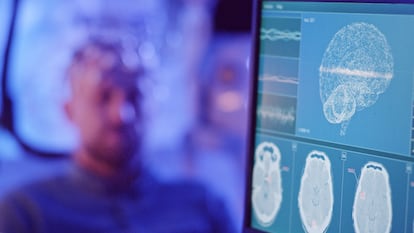A macroproject publishes a brain atlas, a map for understanding what makes us human
The research, which is akin to human genome sequencing, also explores the changes caused by neurological diseases

1600 was a stellar year in the history of science. Tycho Brahe, a Danish nobleman obsessed with accurately measuring the motion of the stars, met in Prague with Johannes Kepler, a German of humble origins with a penchant for mysticism and science that seems contradictory today. Inspired by Copernicus, Kepler intuited that the solar system made more sense with the sun at the center, but he needed data to corroborate his model. At that time, astronomers made charts and astrological predictions from crude observations collected centuries earlier; few felt it necessary to collect precise measurements. Brahe had accumulated such measurements, but he put the Earth at the center of his solar system and hid his observations from Kepler, who could only access them after the Dane’s death in 1601. That data allowed Kepler to mathematically describe the motions of the planets around the Sun and paved the way for Isaac Newton to explain why they move the way they do with the concept of gravity.
Four centuries later, researchers aspire to a scientific revolution that is equally if not more significant than the one led by those who discovered the Earth’s position in the cosmos. Despite the progress in neuroscience since Santiago Ramón y Cajal’s day, much remains unknown about the brain and how it generates consciousness and memory, as well as the cures for many neurological diseases. Today, the journal Science published a series of articles that show work being done to obtain the data that will form the basis for any significant advances in knowledge.
The work is part of the Brain Initiative Cell Census Network (BICCN), a U.S. National Institutes of Health (NIH) project launched in 2017. The initiative involves hundreds of scientists using the latest technologies to locate cells in human and animal brains and characterize them one by one according to gene expression, shape, and other traits. Scientists have already accomplished this with over 3,000 types of human cells, revealing aspects that distinguish them from those of other primates; that will make it possible to identify, for example, which cells are more prone to specific mutations that cause neurological diseases.
One of the Network’s findings is that, as in cooking, the same ingredients can make different dishes. Although there are cells specific to some brain regions, many differences between regions occur because they have different proportions of the same type of cell. As Alyssa Weninger and Paola Arlotta, of the University of North Carolina and Harvard University, respectively, explain in one of the articles, there are exceptions to this general rule. For example, the primary visual cortex contained specific types of inhibitory neurons. The data shows that evolution has not caused the emergence of new types of brain cells that account for different brain functions, but rather that distinct brain circuits are created by small variations within the same cell types and changes in the amount of these cells in a region.
“There is no prototypical human”
Juan Lerma, a researcher at the Instituto de Neurociencias de Alicante [Alicante Institute of Neuroscience] in Spain, points out that the huge amount of data obtained with the new techniques “is not going to give us the solution to the problems of understanding the human brain and reveals things that were already known, but this is the way to demonstrate that this knowledge is solid. One of the highlights for Lerma is the great variability found among brains, “which had been observed in noninvasive brain imaging tests in humans.”
“This tells us that it is important for human studies to include a large number of cases, because you can have a study with 500 brains that gives you some results, and then you do an analysis of 30 of those brains and the results are different,” he says. In a study led by Nelson Johansen of the Allen Institute in Seattle, Washington, researchers analyzed the gene expression of individual cerebral cortex cells from 75 individuals and only found small differences that could be explained by factors such as age, sex, ancestry and whether they came from healthy or sick people. “There is no prototypical human,” Weninger and Arlotta summarize.
“The knowledge derived from these studies will be essential for answering some classic questions in neuroscience, such as what the fundamental differences are between the human brain and that of our closest relatives, like chimpanzees,” says Ignacio Sáez, a researcher at Mount Sinai Hospital in New York.
In one of the papers published in Science today, lead author Nikolas Jorstad of the Allen Institute analyzes the gene expression of cells in the medial temporal gyrus, a region critical for language comprehension in humans, chimpanzees, gorillas, macaques and marmosets. The researchers observed that all these primates share mostly the same cell types that appeared at one point in their evolution and have been retained with the emergence of new species. Only a few hundred genes showed expression patterns that are seen only in humans. These data suggest that the obvious differences between a marmoset and a human stem from a few molecular and cellular changes.
The articles in Science also include research that analyzes cells at key moments in brain development before and just after birth. Learning about these moments can help to produce better models for studying the human brain, which is very difficult to do with flesh-and-blood volunteers, and to better understand which animal models can be useful for advancing our knowledge of the brain. Arlotta is a leading international expert in constructing organoids, which are three-dimensional models created from stem cells that simulate the brain’s structure.
Javier de Felipe, a Spanish National Research Council researcher who has participated in major international research collaborations such as the Human Brain Project, believes that this type of initiative helps “to improve communication between scientists,” enabling them to define precisely “how many types of neurons there are in the brain; that is something we do not know [yet]. It also allows us to see the relationship between the cells’ genetic and morphological characteristics and the functions they perform. These types of projects give us a lot of data that we will then have to begin to make sense of,” he explains. Juan Lerma agrees that this project, “like the sequencing of the human genome, is a map.” He adds that “when you have a map of a territory, the next thing you have to do is start exploring that territory.”
As in the case of Brahe and Kepler 400 years ago, the data, and the expensive and precise tools needed to obtain it, will precede the great discoveries that change our vision of the world, even for those who do not understand transcriptomics or planetary movements. Now as then, a tycoon’s money is funding this project to learn all of the cells of the brain, their location and their functions. In 2003, Paul Allen, the co-founder of Microsoft who died in 2018, established the Allen Institute for Brain Science, which is the organization that is leading the initiative alongside the NIH. However, unlike the Danish nobleman, the Allen Institute will make the data obtained in this project available to all the scientists who want to use the information to learn about reality.
Sign up for our weekly newsletter to get more English-language news coverage from EL PAÍS USA Edition
Tu suscripción se está usando en otro dispositivo
¿Quieres añadir otro usuario a tu suscripción?
Si continúas leyendo en este dispositivo, no se podrá leer en el otro.
FlechaTu suscripción se está usando en otro dispositivo y solo puedes acceder a EL PAÍS desde un dispositivo a la vez.
Si quieres compartir tu cuenta, cambia tu suscripción a la modalidad Premium, así podrás añadir otro usuario. Cada uno accederá con su propia cuenta de email, lo que os permitirá personalizar vuestra experiencia en EL PAÍS.
¿Tienes una suscripción de empresa? Accede aquí para contratar más cuentas.
En el caso de no saber quién está usando tu cuenta, te recomendamos cambiar tu contraseña aquí.
Si decides continuar compartiendo tu cuenta, este mensaje se mostrará en tu dispositivo y en el de la otra persona que está usando tu cuenta de forma indefinida, afectando a tu experiencia de lectura. Puedes consultar aquí los términos y condiciones de la suscripción digital.











































